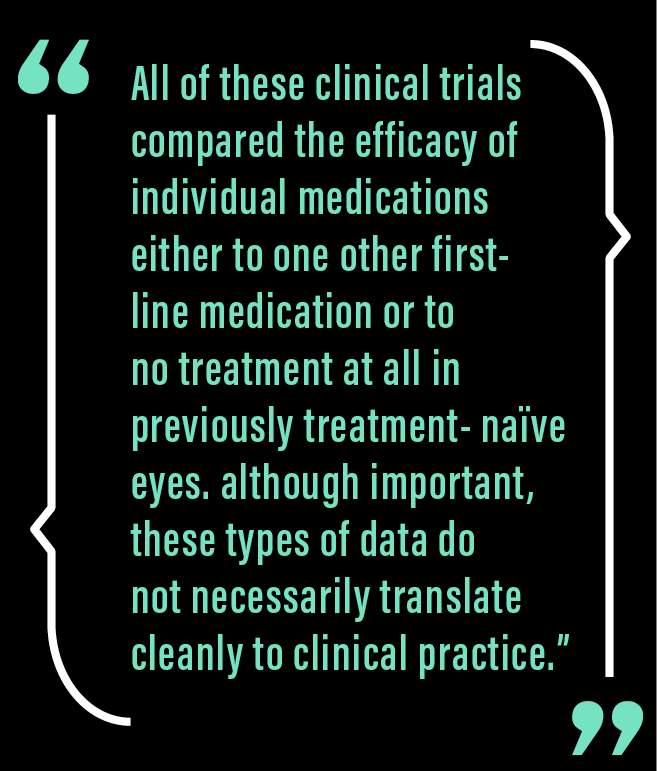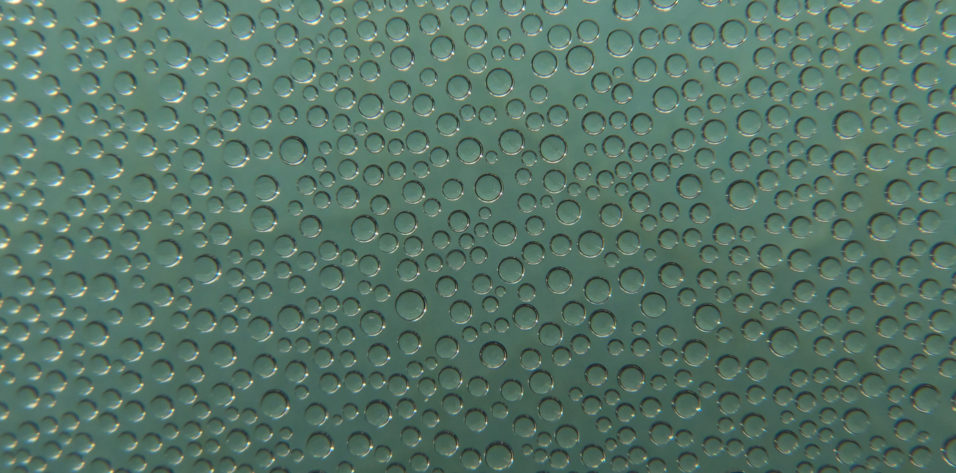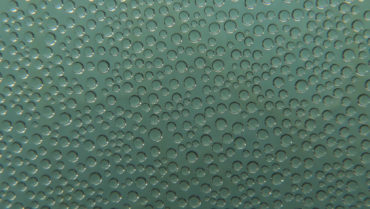The year 2017 saw the much-anticipated release of two new medical glaucoma therapies after a long period of quiescence dating back to the release of prostaglandin analogues in 1996. Both netarsudil 0.02% (Rhopressa, Aerie Pharmaceuticals) and latanoprostene bunod 0.024% (Vyzulta, Bausch + Lomb) use novel alternative pathways to lower IOP. However, as is the case when most new medications come to market, insurance coverage for these drugs is not universal and typically requires prior authorization. As a result, these agents are often used concurrently as additive therapies for IOP reduction. This article briefly reviews clinical trial data and our experience using these medications as adjuncts in a real-life tertiary care practice.
CLINICAL EVIDENCE
Netarsudil 0.02% received FDA approval in December 2017 for the treatment of open-angle glaucoma (OAG) and ocular hypertension (OHT). The drug works mainly as a Rho kinase inhibitor that, through its downstream effects, facilitates trabecular meshwork (TM) outflow. Although a prior phase 2 clinical trial found netarsudil 0.02% to be less effective than latanoprost 0.005% in unmedicated patients, netarsudil and latanoprost were found to be equally effective in a subset of patients with IOPs lower than 26 mm Hg.1 Furthermore, three of the phase 3 ROCKET clinical trials (ROCKET-1, -2, and -4) found netarsudil to be noninferior to twice-daily timolol 0.05% in eyes with IOPs between 20 and 30 mm Hg.2

Latanoprostene bunod 0.024% received FDA approval in November 2017 for the treatment of OAG and OHT. The main additional mechanism in latanoprostene bunod is nitric oxide donation, which also improves TM outflow through downstream effects. The phase 2 VOYAGER trial found that latanoprostene bunod provided significantly greater IOP reduction compared with latanoprost. Phase 3 clinical trials (APOLLO and LUNAR) compared the efficacy of latanoprostene bunod to twice-daily timolol and found significantly lower and sustained IOP reduction favoring latanoprostene bunod for up to 3 months. Additionally, in the open-label phase 3 JUPITER trial, Japanese patients treated with latanoprostene bunod experienced significant pressure reductions even when their baseline IOP was lower than 21 mm Hg.1 All of these clinical trials compared the efficacy of individual medications either to one other first-line medication or to no treatment at all in previously treatment-naïve eyes. Although important, these types of data do not necessarily translate cleanly to clinical practice. In real life, the cost of newly available branded medications can be substantial, and these drugs may initially lack insurance coverage. These barriers typically preclude their use as first-line medications and slow their adoption in clinical practice.
The phase 4 Multicenter Open-label Study (MOST) was recently completed. This was the first trial that aimed to assess the efficacy of the concomitant use of netasurdil with other standard therapies. The results showed an IOP reduction from a baseline of 4.3 mm Hg when netarsudil was added to prostaglandin analogue therapy and an IOP reduction of 4.5 mm Hg when netarsudil was added to therapy with two or more topical medications (data on file, Aerie Pharmaceuticals). Additionally, recent data on the concomitant use of netarsudil with other IOP-lowering agents showed that netarsudil reduced IOP by a mean of 17.0% (standard deviation, 16.8%) at 12 weeks when added to two to five other topical agents.3 Full trial results have not yet been published. Unfortunately, to date, there are no published data on the concomitant use of latanoprostene bunod with other topical medications.
Although all trial data have been collected primarily from patients with OAG and OHT, these novel medications are used by physicians for a wider spectrum of glaucoma types. Currently, there are no published data evaluating their efficacy in other glaucomatous processes, such as normal-tension, neovascular, angle-recession, angle-closure, and childhood glaucoma.
CLINICAL EXPERIENCE
Like many other tertiary care centers, our practice frequently treats patients with various etiologies of refractory glaucoma who must use multiple forms of therapy. Our treatment approach is also, at times, hindered by the burden of cost, particularly for under- and uninsured patients. Patient education and poor adherence are also common hurdles. We have noted nevertheless that adding netarsudil and latanoprostene bunod often enables patients with refractory glaucoma to achieve their target IOP.
Our institution is currently conducting a long-term retrospective review to evaluate the efficacy of netarsudil and latanoprostene bunod as add-on therapies in patients with various etiologies of refractory glaucoma. We generally define refractory glaucoma as requiring treatment with three or more topical medications (often in conjunction with surgery) and an IOP above a clinically determined goal. In these difficult cases, a 3-month preliminary analysis showed statistically significant IOP reductions of 2.5 mm Hg (9%) and 2.8 mm Hg (11%) for netarsudil and latanoprostene bunod, respectively. Although we see a benefit to adding these agents in refractory cases, our experience suggests that efficacy is lower than reported in the MOST trial, which included healthier eyes.
CONCLUSION
Glaucoma is a heterogeneous group of diseases. Published data and our experience support targeting the TM for IOP reduction even in eyes with advanced pathology, although we are finding that the IOP reduction is less pronounced in clinical practice than in the clinical trials. The additional benefits of restoring natural outflow through the TM may have other advantages for rejuvenating the downstream conventional aqueous channels. We hope future research will explore the benefits of such a restoration for the natural course of glaucoma.
1. Jiang Y, Ondeck C. A review of new medications and future directions of medical therapies in glaucoma. Semin Ophthalmol. 2020;35(5):280-286.
2. Khouri AS, Serle JB, Bacharach J, et al. Once-daily netarsudil versus twice-daily timolol in patients with elevated intraocular pressure: the randomized phase 3 ROCKET-4 study. Am J Ophthalmol. 2019;204:97-104.
3. A multicenter, open-label study of Rhopressa (netarsudil ophthalmic solution) 0.02% for the reduction of elevated intraocular pressure in patients with glaucoma or ocular hypertension in a real-world setting. ClinicalTrials.gov identifier: NCT03808688. Accessed January 1, 2021. https://clinicaltrials.gov/ct2/show/study/NCT03808688




